DID YOU KNOW that the average American consumes 1.8 pounds of gum each year? With so much gum going into our mouths it’s important to know how chewing gum affects our dental health. You may have heard that it’s both good and bad for your teeth… so what’s the real answer? Read on to find out!
Avoid Chewing Gum Sweetened With Sugar
Gum has always been a childhood favorite! What child doesn’t love that sweet burst of flavor or a bubble-blowing competition with friends? Unfortunately, gum sweetened with sugar is bad news for teeth.
When you or your child choose sugary chewing gum, you’re not the only ones satisfying your sweet tooth. The bacteria in our mouths like sugar too! And they enjoy it long after we’ve spit our gum out. These bacteria use sugar as fuel, producing acids that weaken tooth enamel and cause cavities.
Stick To Sugarless Gum
Here’s the good news: chewing sugar-free gum can actually boost your oral health! Chewing gum increases saliva flow in your mouth, strengthening your teeth and washing away food debris and bacteria. While the same is true for sugary gum, the increased saliva flow isn’t quite enough to offset the damage that the sugar can do.
According to the American Dental Association, studies show that chewing sugarless gum for 20 minutes after a meal can prevent tooth decay. Saliva helps neutralize acids in our mouths after eating. It also contains calcium and phosphate which strengthen tooth enamel, our teeth’s first line of defense against cavity-causing bacteria.
So, when choosing gum, “stick” to the sugarless kind!
Gum Can’t Replace Good Oral Hygiene
Chewing sugar-free gum can only act as a supplement to your daily oral hygiene routine and can’t replace daily brushing and flossing. Keep up your everyday mouth-healthy habits and you’ll have strong, beautiful teeth for life!
Check out the video below to learn more about how chewing sugarless gum can supplement your oral hygiene routine!
https://www.youtube.com/watch?v=hOOv2pwqsPw
https://www.youtube.com/watch?v=hOOv2pwqsPw
Make The Right Choice For Your Smile
Chewing gum is fun and delicious! But remember, the type of gum you choose can make a big difference for your teeth. So next time you’re at the checkout counter and reach for a pack of gum, make sure it’s sugar-free. Your smile will thank you!
We love to treat you! Thank you for supporting our practice.
The content on this blog is not intended to be a substitute for professional medical advice, diagnosis, or treatment. Always seek the advice of qualified health providers with questions you may have regarding medical conditions.












